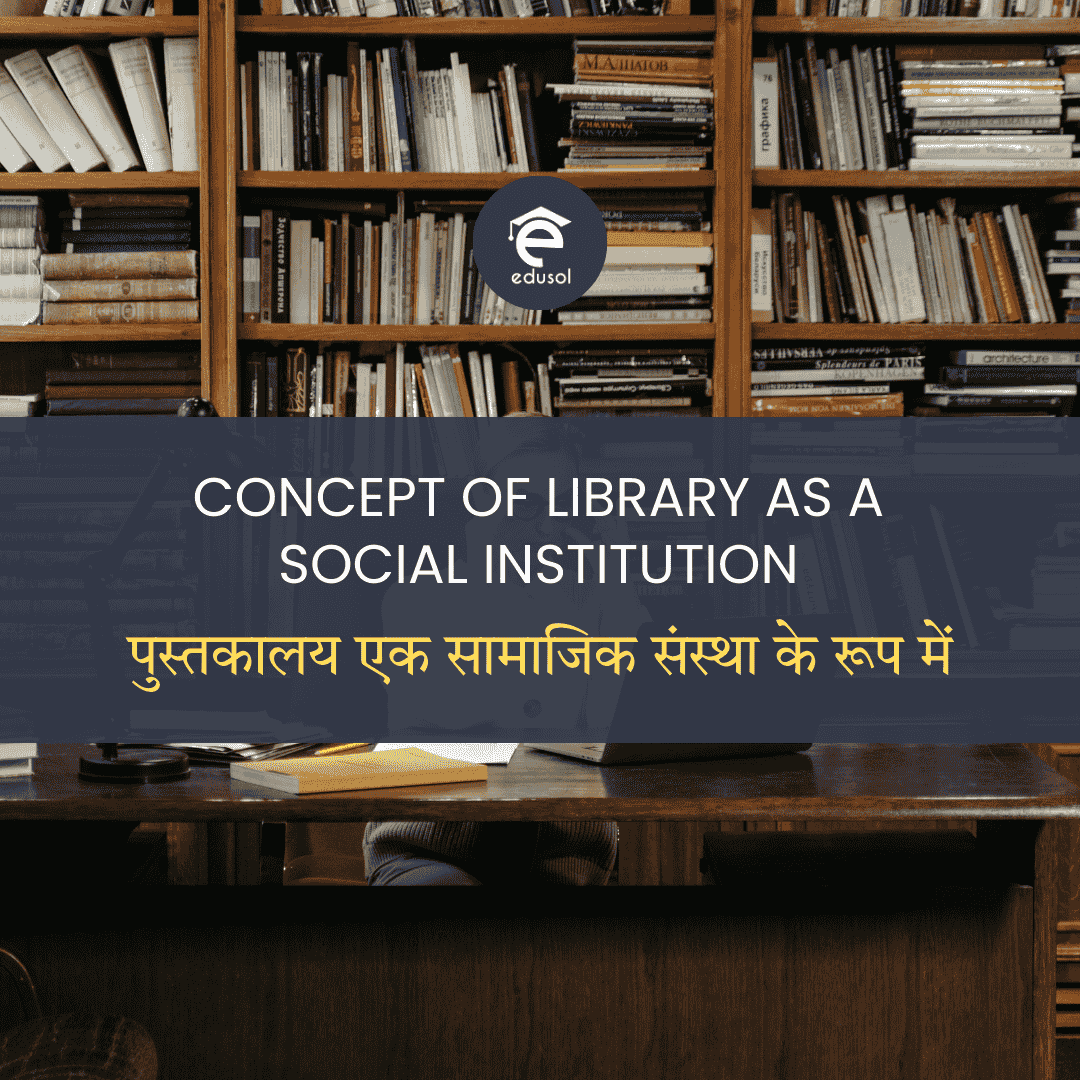Definition
A library is a social institution that acts as a repository of knowledge, providing access to information, education, and cultural resources for individuals and communities. It is an organized system designed to collect, preserve, and disseminate knowledge, serving as a link between past, present, and future while promoting social progress.
Historical Foundations
- Ancient Origins:
- Libraries began in ancient civilizations as centers for learning and preservation.
- Examples include Mesopotamia (clay tablets, 2600 BCE), Egypt (Library of Alexandria, 3rd century BCE), and India (Nalanda University Library, 5th century CE).
- Medieval Period:
- Libraries were tied to religious and scholarly institutions.
- Monastic libraries in Europe preserved Christian texts, while Islamic libraries like the House of Wisdom (Baghdad, 8th-9th century) advanced knowledge through translations.
- Modern Era:
- The printing press (1440, Johannes Gutenberg) made books widely available, leading to public libraries.
- The 19th century saw national and public library movements (e.g., UK’s Public Libraries Act, 1850).
- India’s Context:
- Libraries evolved from ancient centers (e.g., Takshashila) to colonial institutions (e.g., Asiatic Society Library, 1784) and modern public systems.
- Post-independence, the National Library of India (1836) and RRRLF (1972) strengthened library networks.
Social Foundations

- Role in Society:
- Education: Supports formal and informal learning with resources like books and journals.
- Equality: Offers free access, reducing socio-economic disparities.
- Culture: Preserves heritage (e.g., manuscripts) and fosters cultural exchange.
- Community Hub:
- Libraries are spaces for social interaction, literacy programs, and community activities.
- Five Laws of Library Science (S.R. Ranganathan):
- These laws emphasize the library’s social purpose:
- “Books are for use” – Accessibility.
- “Every reader his/her book” – Inclusivity.
- “Every book its reader” – Relevance.
- These laws emphasize the library’s social purpose:
- Modern Relevance:
- Digital libraries (e.g., NDLI) extend access, aligning with global inclusivity trends.
Example
- EMRS Libraries: In Eklavya Model Residential Schools, libraries provide tribal students with books in local languages and digital resources, supporting education and cultural preservation while fostering community engagement through reading programs.
Hindi: पुस्तकालय एक सामाजिक संस्था के रूप में
परिभाषा
पुस्तकालय एक सामाजिक संस्था है जो ज्ञान का भंडार है और व्यक्तियों व समुदायों के लिए सूचना, शिक्षा और सांस्कृतिक संसाधनों तक पहुँच प्रदान करता है। यह एक संगठित प्रणाली है जो ज्ञान को संग्रहित, संरक्षित और प्रसारित करती है, अतीत, वर्तमान और भविष्य को जोड़ती है और सामाजिक प्रगति को बढ़ावा देती है।
ऐतिहासिक आधार
- प्राचीन उत्पत्ति:
- पुस्तकालय प्राचीन सभ्यताओं में शुरू हुए, जैसे मेसोपोटामिया (मिट्टी की पट्टियाँ, 2600 ईसा पूर्व), मिस्र (अलेक्जेंड्रिया पुस्तकालय, तीसरी शताब्दी ईसा पूर्व), और भारत (नालंदा विश्वविद्यालय पुस्तकालय, पाँचवीं शताब्दी)।
- मध्यकाल:
- पुस्तकालय धार्मिक और विद्वत संस्थानों से जुड़े थे।
- यूरोप में मठवासी पुस्तकालयों ने ईसाई ग्रंथ संरक्षित किए, जबकि बगदाद का हाउस ऑफ विजडम (8वीं-9वीं शताब्दी) ने अनुवाद के माध्यम से ज्ञान बढ़ाया।
- आधुनिक युग:
- मुद्रण यंत्र (1440, जोहान्स गुटेनबर्ग) ने पुस्तकों को सुलभ बनाया, जिससे सार्वजनिक पुस्तकालय बने।
- 19वीं शताब्दी में राष्ट्रीय और सार्वजनिक पुस्तकालय आंदोलन शुरू हुए (जैसे, यूके का पब्लिक लाइब्रेरी एक्ट, 1850)।
- भारत का संदर्भ:
- पुस्तकालय तक्षशिला जैसे प्राचीन केंद्रों से औपनिवेशिक (एशियाटिक सोसाइटी पुस्तकालय, 1784) और आधुनिक प्रणालियों तक विकसित हुए।
- स्वतंत्रता के बाद, राष्ट्रीय पुस्तकालय भारत (1836) और RRRLF (1972) ने पुस्तकालय नेटवर्क को मजबूत किया।
सामाजिक आधार
- समाज में भूमिका:
- शिक्षा: औपचारिक और अनौपचारिक शिक्षा के लिए संसाधन (पुस्तकें, पत्रिकाएँ) देता है।
- समानता: मुफ्त पहुँच से सामाजिक-आर्थिक असमानता कम करता है।
- संस्कृति: विरासत (पांडुलिपियाँ) को संरक्षित करता है और सांस्कृतिक आदान-प्रदान को बढ़ावा देता है।
- सामुदायिक केंद्र:
- पुस्तकालय सामाजिक मेलजोल, साक्षरता कार्यक्रमों और सामुदायिक गतिविधियों के स्थान हैं।
- पुस्तकालय विज्ञान के पाँच नियम (एस.आर. रंगनाथन):
- ये नियम सामाजिक उद्देश्य पर जोर देते हैं:
- “पुस्तकें उपयोग के लिए हैं” – पहुँच।
- “हर पाठक को उसकी पुस्तक” – समावेशिता।
- “हर पुस्तक को उसका पाठक” – प्रासंगिकता।
- ये नियम सामाजिक उद्देश्य पर जोर देते हैं:
- आधुनिक प्रासंगिकता:
- डिजिटल पुस्तकालय (जैसे, NDLI) वैश्विक पहुँच बढ़ाते हैं।
उदाहरण
- EMRS पुस्तकालय: एकलव्य मॉडल आवासीय विद्यालयों में पुस्तकालय जनजातीय छात्रों को स्थानीय भाषाओं में पुस्तकें और डिजिटल संसाधन प्रदान करते हैं, शिक्षा और सांस्कृतिक संरक्षण को समर्थन देते हैं और पठन कार्यक्रमों के माध्यम से सामुदायिक सहभागिता को बढ़ावा देते हैं।
Bilingual MCQs for Librarian Exam
MCQ 1
English: Which ancient library was a major center for scholars like Euclid?
(a) Library of Alexandria
(b) Nalanda Library
(c) House of Wisdom
(d) British Library
Answer: (a) Library of Alexandria
Hindi: कौन सा प्राचीन पुस्तकालय यूक्लिड जैसे विद्वानों के लिए प्रमुख केंद्र था?
(a) अलेक्जेंड्रिया पुस्तकालय
(b) नालंदा पुस्तकालय
(c) हाउस ऑफ विजडम
(d) ब्रिटिश लाइब्रेरी
उत्तर: (a) अलेक्जेंड्रिया पुस्तकालय
MCQ 2
English: Which invention revolutionized access to knowledge, leading to public libraries?
(a) Internet
(b) Printing Press
(c) Digital Library
(d) Radio
Answer: (b) Printing Press
Hindi: किस आविष्कार ने ज्ञान तक पहुँच में क्रांति लाकर सार्वजनिक पुस्तकालयों की शुरुआत की?
(a) इंटरनेट
(b) मुद्रण यंत्र
(c) डिजिटल पुस्तकालय
(d) रेडियो
उत्तर: (b) मुद्रण यंत्र
MCQ 3
English: Which of Ranganathan’s laws emphasizes accessibility of libraries?
(a) Books are for use
(b) Every reader his/her book
(c) Every book its reader
(d) Save the time of the reader
Answer: (a) Books are for use
Hindi: रंगनाथन के कौन से नियम पुस्तकालयों की पहुँच पर जोर देते हैं?
(a) पुस्तकें उपयोग के लिए हैं
(b) हर पाठक को उसकी पुस्तक
(c) हर पुस्तक को उसका पाठक
(d) पाठक का समय बचाओ
उत्तर: (a) पुस्तकें उपयोग के लिए हैं
MCQ 4
English: Which Indian initiative supports public library development?
(a) National Library of India
(b) RRRLF
(c) INFLIBNET
(d) DELNET
Answer: (b) RRRLF
Hindi: कौन सी भारतीय पहल सार्वजनिक पुस्तकालय विकास का समर्थन करती है?
(a) राष्ट्रीय पुस्तकालय भारत
(b) RRRLF
(c) INFLIBNET
(d) DELNET
उत्तर: (b) RRRLF



